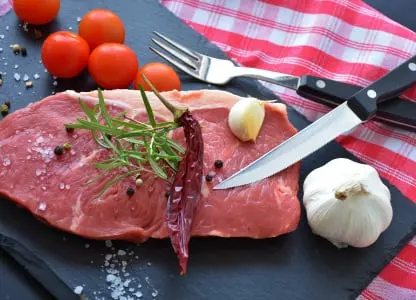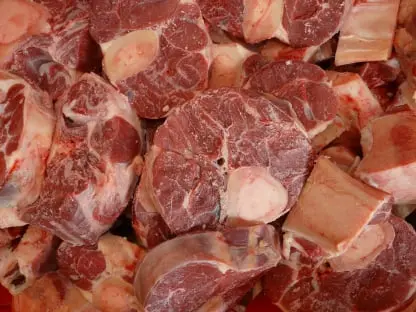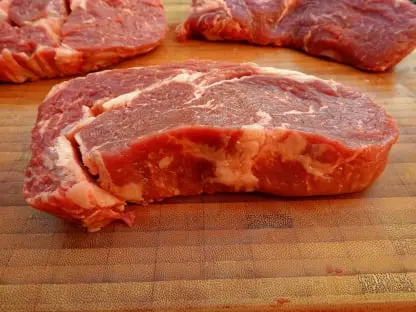Beef food safety app:
Beef food safety app with AI Food Safety for inspecting livestock, head during harvesting, beef ageing, beef fabrication, and beef packaging & shipping.

Beef Supplier Food Safety & management
Many types of bacteria can grow on animal products, so it’s important to safely handle and store all types of meat. However, the different rules for handling different types of meat can be confusing. It may be perfectly safe to eat some meat a week after it was prepared or to freeze it for later. Other types should be thrown away after only a few days.
Safety issues are associated with everything you may eat. A healthy kitchen depends on your knowledge of safe cooking and storage practices.
Selecting meat
Never buy meat that’s past the expiration or sell-by date. Also, buy meats at the store after you’ve found all your other items to decrease the time the meat is out of refrigeration.
Follow these specific guidelines when selecting certain meats:
Avoid any beef or pork that’s dark brown or discolored, has a strong odor, or feels tough or slimy.
Avoid any poultry that looks faded, has a strong odor, or feels tough or slimy.
Avoid any fish that’s faded or discolored, has squishy or slimy flesh, and has a strong fishy or ammonia-like odor.
Avoid any meat that’s in damaged, leaking, or torn packages, as it’s likely been exposed to the air and harmful bacteria.
Handling meat
Wash your hands frequently when preparing any type of meat, fish, or poultry. Bacteria can quickly spread between your hands and meat. Always wash your hands with soap and water for at least 20 seconds before and after handling meat, whether it’s raw or cooked.
Because bacteria can spread easily, prepare the meat on a surface that’s separate from all other cooking materials. Keep vegetables and other ingredients away from meat, especially if you aren’t cooking them together in the same dish.
Try to use separate cutting boards, clean all cooking utensils after they touch raw meat, and use different utensils to serve food after you’ve prepared it.

Beef Food Safetys during production
View app Specifications.
Chill: Refrigerate promptly.
Bacteria can multiply rapidly if left at room temperature or in the “Danger Zone” between 40°F and 140°F.
Keep your refrigerator at 40°F or below and your freezer at 0°F or below, and know when to throw food out before it spoils. If your refrigerator doesn’t have a built-in thermometer, keep an appliance thermometer inside it to check the temperature.
Package warm or hot food into several clean, shallow containers and then refrigerate. It is okay to put small portions of hot food in the refrigerator since they will chill faster.
Refrigerate perishable food (meat, seafood, dairy, cut fruit, some vegetables, and cooked leftovers) within 2 hours. If the food is exposed to temperatures above 90°F, like a hot car or picnic, refrigerate it within 1 hour.
Thaw frozen food safely in the refrigerator, in cold water, or in the microwave. Never thaw food on the counter because bacteria multiply quickly in the parts of the food that reach room temperature.

Beef Food safety & management
Many different types of bacteria can grow on animal products. It’s important to safely handle and store all types of meat. However, many people find it confusing that different types of meat have different handling rules. It may be perfectly safe to eat one type of meat a week after it was prepared or freeze it to eat later. However, other types should be thrown away after only a few days or kept unfrozen. Safe ShoppingNever choose packages that are torn or leaking.Do not buy foods past “sell-by” or expiration dates.Place raw meat and poultry in plastic bags so meat juices cannot cross-contaminate other foods. Safe Storage of FoodsPlace securely wrapped packages of raw meat, poultry, or fish in the meat drawer or coldest section of your refrigerator.Cook or freeze fresh poultry, fish, ground meats, and organ meats within 2 days; other beef, veal, lamb, or pork within 3 to 5 days.Keep meat and poultry in its package until just before using.If freezing meat and poultry in its original package longer than 2 months, overwrap these packages with airtight heavy-duty foil, plastic wrap, freezer paper or plastic freezer bags.Meat and poultry defrosted in the refrigerator may be refrozen before or after cooking. If thawed by other methods, cook before refreezing. Thaw Food SafelyA refrigerator allows slow, safe thawing. Make sure thawing juices do not drip on other foods.For faster thawing, place food in a leak-proof plastic bag and submerge in cold tap water.If using a microwave to defrost, cook meat or poultry immediately after thawing.

Daily Beef factory hygiene checklist
The EU Food Safety system improves the quality and safety of meat and meat products for consumers and protects animals from unnecessary suffering. EFSA's scientific advice supports this system along the entire food chain.
1. Farm safety
rearing/housing
food-borne animal-to-human diseases
nutrition/feed safety
EU response to Salmonella Human cases fell by almost 50% over 5 years (2004 to 2009).
2. Slaughter
inspection methods
decontamination processes/ substances
conditions of hygiene
welfare at slaughter
Meat inspection (2013)
An integrated approach covering animal health/ welfare and biological/ chemical contamination.
3. Preparation and processing
preservation
flavourings
gelling agents
mechanical processing
Nitrates/ nitrites in meat (2017)
Additives used to preserve meat hinder microbial growth (particularly bacteria that cause botulism), food operators use them to keep meat red and enhance flavour.
4. Storage, packaging, consumption
time/temperature
wholesale/retail/home
packaging materials
nutrition advice
Meat spoilageduring storage and transport (2016)
Impact of time, temperature on bacterial growth in beef, pork, lamb, poultry.
Science and the EU food safety system
Risk managers at European and national level use EFSA's scientific advice to help them develop appropriate rules, inspection methods and monitoring programmes that ensure meat safety.